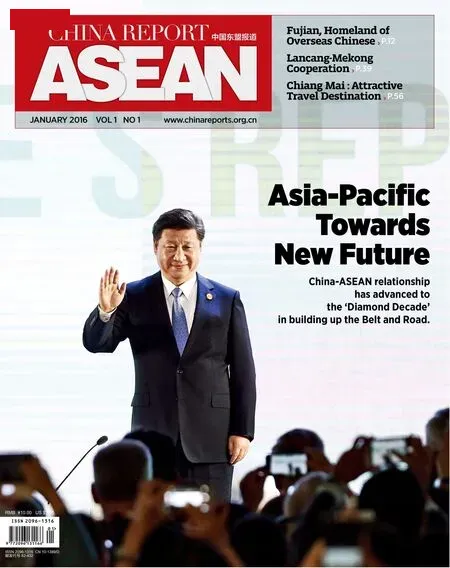Unity among China and ASEAN States
By Jasemin Sibo Ho
Unity among China and ASEAN States
By Jasemin Sibo Ho
Chinese Premier Li Keqiang was recently in Malaysia to address the 18th ASEANChina summit in Kuala Lumpur on Nov 21, 2015.
Malaysian Prime Minister Najib Razak held a grand welcome ceremony for his Chinese visitor making his frst trip to Malaysia since taking ofce in 2013.
ASEAN's warm welcome for China's extended partnership, as can be attested by the “red carpet” treatment given by the head of states for Premier Li. China has stepped up efforts on its Belt and Road Initiative, which aims to create multiple economic corridors spanning more than 60 countries across the world. ASEAN diplomats believe China's 21st Century Maritime Silk Road Initiative can help to spur economic development in the region involved, and transform ASEAN into a single market and production base in order to boost the region's competitiveness and connectivity globally.
By the same token, the proposed 21st Century Maritime Silk Road passes through regions where China faces territorial issues with neighboring countries, such as the Philippines. However, geopolitical concerns should not hinder economic cooperations between the two nations. Economic development at the very core, translates into a better life for people in all the regions concerned.
As has been observed by famous philosophers down the ages, it is better to have a friend than to make an enemy. Despite inevitable differences in thoughts and actions, these diferences cannot erase the 1,000 years of kinship and camaraderie between Motherland China and Anak Philippines. As long as there are competent leaders helming their respective states and with the peoples' best interests at heart, there is hope that these two allies will continue to solidify their ties in the years to come.
The ASEAN chair for the year of the Wooden Sheep 2015 is Malaysia , my country ,which is home to approximately 8 million Chinese descendants (based on a 2010 census in which Chinese made up 26 percent of the entire population, and using 2015's overall Malaysian population of 30.3 million). A founding ASEAN member and the Organization of Islamic Cooperation(OIC), Malaysia participates in many international organizations such as the United Nations, the Asia-Pacifc Economic Cooperation, the Developing 8 Countries,and the Non-Aligned Movement (NAM). A former British colony, it is also a member of the Commonwealth of Nations.
Malaysia's foreign policy is ofcially based on the principle of neutrality and maintaining peaceful relations with all countries. The government always attaches top priority to the security and stability of Southeast Asia, and endeavors to further develop ties with other countries in the region.
Improving the quality of education is a common challenge faced by Malaysia and her ASEAN peers. Shortage of quality teachers,insufcient funding support by their respective governments and lack of a holistic national curriculum plagues the ASEAN countries.
Education alleviates poverty and propels third world and developing nations to a worldclass developed nation status. Yet, there seems to be a gap between academia and businesses,media and government bodies.
“Te pen is mightier than the sword”. Tis is a common adage held by both the Western and Eastern spheres, yet there is an ongoing debate on which method is superior.
At the same time, the ASEAN colony-Western master co-dependence of bygone eras seems to still exist within fragments of the upper echelons and middle management. It begs the question of whether the legacy of the education frameworks lef by the former colonial masters failed to incorporate unique local elements, or whether the liberated ASEAN countries lack the fnesse in executing the said frameworks.
It is easy to find a thousand soldiers, but hard to find a good general. (An old Chinese saying)
In my opinion, as a benefciary of both the British and Chinese education systems, there is no superior curriculum. China and ASEAN have time and again proven to be loyal allies,together creating the new regional powerhouse in this Asian century. What academia should focus on is real understanding and leverage on the strengths within China and ASEAN's education systems.
China prides itself on its centuries-old academic foundations based on Confucianism and Taoism. ASEAN's education system is largely influenced by their former colonial masters, mostly British and to some extent European and even American.
Asia is a multicultural, multilingual,multi-ethnic family of nations consisting of homogenous and heterogeneous societies. It is certainly no easy feat unifying the nations individually and collectively. It would require a certain leader with great vision and Sun Tzu's art of war skills to accomplish this feat.
We are living in a globalized world, where cultures blend seamlessly and multicultural inclusiveness is on every country's national agenda. Let us not divide, but unite according to our own individual strengths and uniqueness in creating a truly globalized education system relevant in this 21st Century.
Te Year of 2016 will see the birth of a new ASEAN as a collective region. Chinese Premier Li's recent visit to this region forges a new sense of unity amongst its Asian counterparts as the Motherland lends her support from funding,transfer of knowledge to sharing best practices from her centuries-old Confucius and Sun Tzu teachings.
Te Year of the Red Fire Monkey should be an interesting one, where the ASEAN Tigresses unite as one and China pledges her unwavering support.
About the author:
Jasemin Sibo Ho is a Malaysian Columnist.

